- News
- Reviews
- Bikes
- Accessories
- Accessories - misc
- Computer mounts
- Bags
- Bar ends
- Bike bags & cases
- Bottle cages
- Bottles
- Cameras
- Car racks
- Child seats
- Computers
- Glasses
- GPS units
- Helmets
- Lights - front
- Lights - rear
- Lights - sets
- Locks
- Mirrors
- Mudguards
- Racks
- Pumps & CO2 inflators
- Puncture kits
- Reflectives
- Smart watches
- Stands and racks
- Trailers
- Clothing
- Components
- Bar tape & grips
- Bottom brackets
- Brake & gear cables
- Brake & STI levers
- Brake pads & spares
- Brakes
- Cassettes & freewheels
- Chains
- Chainsets & chainrings
- Derailleurs - front
- Derailleurs - rear
- Forks
- Gear levers & shifters
- Groupsets
- Handlebars & extensions
- Headsets
- Hubs
- Inner tubes
- Pedals
- Quick releases & skewers
- Saddles
- Seatposts
- Stems
- Wheels
- Tyres
- Health, fitness and nutrition
- Tools and workshop
- Miscellaneous
- Buyers Guides
- Features
- Forum
- Recommends
- Podcast
review
£999.99
VERDICT:
Cheerful-to-ride bike that helps make winter training, commuting or audaxes fun
Weight:
10,100g
Contact:
At road.cc every product is thoroughly tested for as long as it takes to get a proper insight into how well it works. Our reviewers are experienced cyclists that we trust to be objective. While we strive to ensure that opinions expressed are backed up by facts, reviews are by their nature an informed opinion, not a definitive verdict. We don't intentionally try to break anything (except locks) but we do try to look for weak points in any design. The overall score is not just an average of the other scores: it reflects both a product's function and value – with value determined by how a product compares with items of similar spec, quality, and price.
What the road.cc scores meanGood scores are more common than bad, because fortunately good products are more common than bad.
- Exceptional
- Excellent
- Very Good
- Good
- Quite good
- Average
- Not so good
- Poor
- Bad
- Appalling
We reviewed the Racelight T2 a couple of years ago but the demands of economics have meant that a few spec changes have had to be forced upon it to keep the price in line with the magic Ride-To-Work thousand pound mark, and give you a penny in change to spend on sweets. One sweet. Half a sweet. Does the revised version still pass muster as an enjoyable all-day ride with excellent commuter or tourer capabilities?
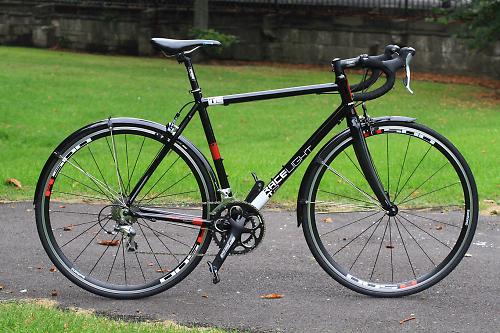
The T2 has become a bit of a modern classic, helped by the ride character and the price. The frame only is £239.99 should you wish to divert funds that way. Its popularity is also helped by its mudguard friendliness and the wide range of 48, 51, 54, 57, 60 and 63cm sizes.
The Kinesis Racelight frame is made from double butted 7005 alloy, a tough, dependable but light weight tubing according to Kinesis, and something that can be welded without requiring an expensive heat-treating process. Calling it lightweight might be a misnomer in today's lexicon of what passes for svelte in the bike world, welterweight might be more accurate.

In the crowded curvy carbon peloton it's nice to see a bike that doesn't look like it's melted a bit. The Kinesis is put together with mostly straight and slender tubes giving it a clean look, but that surface simplicity hides a few nice touches. The head tube has an hourglass figure, the down tube is subtly shaped to keep things tight top and bottom, and further back the rear stays are tuned to be what Kinesis call 'Anti Roadshock', which means they're double-butted and with curves in to soften up the rear triangle a little, and give a bit of heel clearance. The chainstays are ovalised as they meet the bottom-bracket to add stiffness and aid tyre clearance and have an elegant flare to them as they head out towards the dropouts.

Features on the frame include gear cable stops on the downtube with adjusters, simple and less of a pain to change cables than anything swanky and internal; bottle cage bosses feature on both the down and seat tubes for long days; there are rack mounts on the rear triangle for luggage capacity; and a chain pip on the right-hand seatstay. A what? A chain pip, for neatly holding the chain on the frame when you take the rear wheel out. A lovely thing you hardly ever see any more.

The welds joining everything together aren't the prettiest but as a package you could call the T2 an understated looker. The paint job is well done and nicely shiny shiny, and all the bits hung off it are well coordinated so it looks a tidy bike and easy on the eye. You could happily ride it home to your mother and she'd offer it cake.
The Future Forms SP-33S mudguards offer good solid coverage from whatever the weather can throw at you, although hardcore riders might want to bolt a flap to the front for further foot protection. They can get a bit rattly on really rough roads. There's plenty of room in the frame for the mudguards and 700x25 tyres supplied but ditch the guards and you can fit a 28mm tyre in there should you wish to extend the bike's horizons.

The saddle on any bike is a Marmite issue but you're probably going to chuck the Kinesis branded WTB saddle right away for something more preferable. It's not an uncomfortable saddle by any means but the half matte/half shiny finish it's been given in the name of aesthetics makes it unusable on a road bike. The gloss half of the saddle is annoyingly sticky. This might be handy for a mountain or cyclo-cross bike when you need a bit of grip on your bum for helping with wet and mud issues but on a road bike where subtle saddle shifts are almost constant it's a pain in the arse, literally. To make any movements in the saddle means lifting up and then setting down again, and the gloss half squeaks too. The saddle lasted one ride before I swapped it for something less annoying.
The Freedom tyres, made by WTB, are great winter use rubber. They're stout, puncture averse and confidently grippy, even in the slimy conditions you get the dark half of the year, and their 25mm width makes for a comfortable ride over season-stressed roads too. The downside to this is that they're not the most responsive tyres out there - swings, roundabouts and all that - so while they're great for trundling out the winter miles or keeping you safe on a commute if you wanted something chipper for a more lively ride or going for a silver on a sportive then swapping tyres would be advisable.
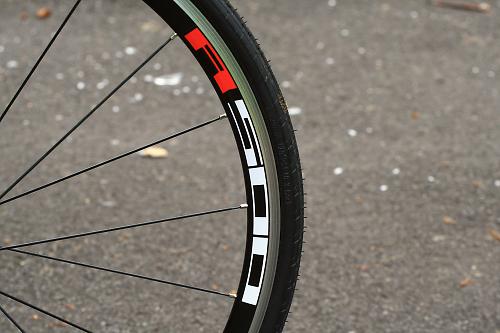
In a similar fashion the Shimano R501 clincher wheels are sturdy, bombproof workhorses that aren't going to set the ride alight, but as a bonus to all-weather riders they have cup and cone bearings so if you know your way around some cone spanners and a grease gun they should offer the promise of better longevity than so called sealed bearing hubs.
The Tiagra based drivetrain works really well, with a lightness of touch that belies its place on the lower rungs of the component ladder. It might not be as light or as crisp as its bigger brothers but you really can't complain about the performance at all; it does the job without any fuss. Only the exposed gear cables coming out the sides of the shifters might cause concern to those that are overly grumbly about old-fashioned brifters.

The deviation from the Tiagra gear portfolio comes in the shape of an FSA Vero Compact 34/50 chainset, poked through an FSA Power Spline bottom bracket. Again, it's a combination that's not going to set hearts a flutter but it does the job and the 34/50 rings combined with the Tiagra 12-28 ten speed cassette should get you up pretty much anything, even if you're carrying a few extra thermal pounds or bags on the back.
Joining the rings and cogs together is a 10-speed KMC chain, complete with a split link, so taking a wintergrimy chain off to give it a proper dunk in your favourite cleaning solution is an easy and life-extending job.

As well as the chainset FSA supplies the lion's share of ancillaries with the SL 280 layback seatpost, OS 168 stem and Vero compact bars. None of it is going to get your club-mates staring at it in envy but it all just works. The seatpost has a fair amount of setback to it, so getting the right saddle position shouldn't be a bother for anyone and its 27.2 diameter allows the possibility of a bit more comfort-giving flex than a girthier seatpost. The bars are a common comfortable compact shape and the stem holding them is black and conforms to the collar-and-cuffs matching seatpost-and-stem rule.
Braking is dealt with by Tektro R317 Long Drop calipers but they're a little bit disappointing when it comes to bringing the T2 to a halt. They're not by any means terrifyingly bad but just a little lack-lustre in bite and immediacy. Swapping the brake pads makes a significant improvement to performance.

The T2 comes with a DC07 Carbon fork with alloy steerer. For £65 less you can have a Racelight 7075 Alloy fork in there instead, but why would you? The DC07 fork does its job well - you may have noticed a theme with the bike here - making the worst of the road buzz largely unnoticeable.
So what does this all add up to? To put it simply it's a nice bike to ride. If you imagine that a winter road bike is a slow and safe plodder for racking up the miles on crappy roads then you need to have a go on the T2. The handling isn't quite race bike razor-sharp, because you wouldn't want that sort of handful on a bike on dicey roads or with panniers strapped to it, but it certainly isn't at all bargey and boring in posture and as such it likes to have a little bit of fun. If you want to muck about and sprint for signs on the club run the T2 is eager to respond, although it does seem to get sucked down a bit by the reluctant rear end. While the curvy seatstays might add comfort the flattened chainstays to help frame stiffness make the rear triangle feel solid and unresponsive to effort. The chunky wheelset doesn't help matters here either.

For the similar reasons it's not the best climber, it doesn't actively want to sit down on the kerb and have a sulk but it requires cajoling at times and definitely climbs better when actively dancing out of the saddle than when seated.
This doesn't make it an uncomfortable bike to ride though, you can feel the passive rear end when smacking over a hidden hole, but the Freedom tyres do a great job of cushioning the blows of the worst the tarmac can offer, making long rides perfectly palatable. With lighter thinner tyres on it was possible to tell that the T2's frameset isn't as sophisticated as other pricier frames but it never became a weary ride.

To show that there's more to the T2 than the cold and wet it was taken to the Alps for a bit of out of season sunshine. The mudguards came off, the sticky tyres were removed for some more standard road tyres and those stocky stock wheels were swapped for something a little lighter, in roughly the way you might like to upgrade the T2 over time.
In this spry guise the Kinesis didn't disgrace itself in performance or against far more exotic cycling competition. Losing a good pound in the wheels and putting faster rubber really lets the T2's fun character shine brighter. Climbing was still hampered a little by its welter weight but it still managed to hold its own against bikes five times the price and less bothersome on the scales. Descending was well behaved, balanced and totally unfazed by mountain hairpins.
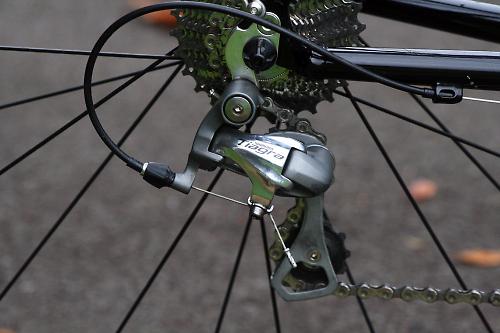
The more energetic character of the bike is reflected in the reach of the frame, which drops it out of the short and tall sportive arena and plonks it in the stretched out for speed peloton. The head tube isn't stupidly short though so it's not an extreme reach, but check the geometry numbers if you prefer a more cruising attitude.
I've never quite understood winter bikes, with their image of boring to ride dependable machines to get you through the shitty months. Why would you want to ride a boring bike? I've always ridden my best bike all year round because it's fun to ride, and because it's my only bike. I've looked after it, and spending money on new components thanks to any premature wear is significantly cheaper than a buying a special bike just to get dirty. It's a system that's stood me well for a lifetime of winter riding.

The Kinesis Racelight T2 has put a massive dent in my theory. The handling is spirited enough to make the colder months that little bit more fun and while it might not be as fast as proper race bike the T2 still likes to go fast, and be pushed at every opportunity putting a smile on your face. And you'll feel the benefit when you jump back on your lighter race bike. Combine that with not getting too emotionally or financially distressed by covering Tiagra in frosty slush with the dry bum and toes benefits of mudguards and with a Racelight T2 there's no reason for winter to be tedious any more.
Verdict
Cheerful-to-ride bike that helps make winter training, commuting or audaxes fun
road.cc test report
Make and model: Kinesis Racelight T2
Size tested: 57 (size pictured 54)
About the bike
State the frame and fork material and method of construction. List the components used to build up the bike.
Frame: 7005 series alloy, double butted tubing
Fork: DC07 carbon with alloy steerer
Headset: FSA Orbit IS
Bar: FSA Vero Compact 420mm x 31.8
Stem: FSA OS-190 110mm 31.8
Seat Post: FSA SL 280
Brakes: Tektro R317 Long Drop Caliper
Crankset: FSA Vero Compact 34/50T
Bottom Bracket: FSA Power Spline 68 x 108mm
Chain: KMC
STI Shifters: Shimano TIAGRA ST-4600
Front Mech: Shimano TIAGRA FD-4600
Rear Mech: Shimano TIAGRA RD-4600SS
Cassette: Shimano TIAGRA CS-4600 12-28T
Saddle: Freedom By WTB KinesisUK AON
Wheelset: Shimano R501
Bar Tape: VELO Black Cork Tape
Tyres: Freedom By WTB Racine
Mudguards: Future Forms SP-33S, 700C
Seat Clamp: Kalloy 31.8mm
Available in Tech White, Supergloss Black and Powder Blue colours
Tell us what the bike is for, and who it's aimed at. What do the manufacturers say about it? How does that compare to your own feelings about the bike?
The Kinesis Racelight T2 uses 7005 series, double butted tubing to give a lightweight, durable and dependable ride. The frame and fork are well proven and is the choice of a huge number of riders in the UK for the winter months. Its hourglass profile stays add comfort for the daily commute, some touring or pounding out those cold weather miles on our UK roads.
Yup, I can see the appeal, it's a fun bike for smashing winter miles out on.
Frame and fork
Overall rating for frame and fork
6/10
Tell us about the build quality and finish of the frame and fork?
The weld quality is a little blobby, but the paint job is tidy and the frame has lots of neat features.
Tell us about the materials used in the frame and fork?
7005 series, double butted alloy tubing and a carbon fork with alloy steerer.
Tell us about the geometry of the frame and fork?
The 73.5 degree head and seat angles on the 57 frame translate to lively handling without being nervously racey.
How was the bike in terms of height and reach? How did it compare to other bikes of the same stated size?
For its size the T2 is definitely longer in the reach than you might expect a winter trainer to be. You might find this desirable, or not.
Riding the bike
Was the bike comfortable to ride? Tell us how you felt about the ride quality.
Yes, comfy enough to make long chilly miles more bearable.
Did the bike feel stiff in the right places? Did any part of the bike feel too stiff or too flexible?
Generally a well balanced bike for longer distance riding, hampered by the unemotional rear end.
How did the bike transfer power? Did it feel efficient?
Stoic enough to cope with excited efforts, but sluggish thanks to wheels and tyres.
Was there any toe-clip overlap with the front wheel? If so, was it a problem?
Not for me, even with mudguards.
How would you describe the steering? Was it lively, neutral or unresponsive? Lively enough to be fun, not too lively to be a handful.
Tell us some more about the handling. How did the bike feel overall? Did it do particular things well or badly?
For a bike designed to eke out the winter it displayed an unexpected penchant for enjoyment.
Which components had the most effect (good or bad) on the bike's comfort? would you recommend any changes?
The 25mm Freedom tyres were soft, grippy and comfortable, while the shape of the saddle was fine the finish on it made it annoying to ride.
Which components had the most effect (good or bad) on the bike's stiffness? would you recommend any changes?
For what it is the T2 was fine.
Which components had the most effect (good or bad) on the bike's efficiency? would you recommend any changes?
The sticky and sluggish Freedom tyres and heavy and clunky Shimano R501 wheels would be the first things to upgrade if you wanted to speed the bike up.
Rate the bike for efficiency of power transfer:
4/10
Rate the bike for acceleration:
4/10
The T2 doesn't necessarily spring forward at every pedal stroke, but it wants to try and rewards effort, eventually.
Rate the bike for sprinting:
4/10
Whilst it's not the bike's forte, given time and willingness it can be wound up to compete in a sprint. Attack from the rear.
Rate the bike for high speed stability:
8/10
Rate the bike for cruising speed stability:
8/10
Rate the bike for low speed stability:
8/10
Rate the bike for flat cornering:
7/10
Rate the bike for cornering on descents:
7/10
Rate the bike for climbing:
4/10
The drivetrain
Rate the drivetrain for performance:
7/10
It all just works.
Rate the drivetrain for durability:
5/10
Rate the drivetrain for weight:
4/10
Rate the drivetrain for value:
8/10
Tell us some more about the drivetrain. Anything you particularly did or didn't like? Any components which didn't work well together?
Really nothing to complain about, and you're not going to cry when it gets covered in grime, the external STI cables might irk some.
Wheels and tyres
Rate the wheels and tyres for performance:
6/10
Sturdy wheels and sticky tyres are great for winter longevity and confidence, but they can stifle any enthusiasm.
Rate the wheels and tyres for durability:
7/10
Rate the wheels and tyres for weight:
4/10
Rate the wheels and tyres for comfort:
7/10
Rate the wheels and tyres for value:
6/10
Tell us some more about the wheels and tyres.Did they work well in the conditions you encountered? Would you change the wheels or tyres? If so, what for?
For the intended use of surviving winter miles on a budget they were spot on, swapping the tyres for something more speedy helped the bike's fun character enormously, as did putting lighter wheels on.
Controls
Rate the controls for performance:
6/10
All good, no fuss kit.
Rate the controls for durability:
7/10
Rate the controls for weight:
5/10
Rate the controls for comfort:
6/10
Rate the controls for value:
7/10
Tell us some more about the controls. Any particularly good or bad components? How would the controls work for larger or smaller riders?
Nothing particularly bad, nothing outstandingly amazing, just good basic stuff.
Your summary
Did you enjoy riding the bike? Yes. It was a bit of a pleasant surprise to be honest.
Would you consider buying the bike? I never thought I'd say this about a winter bike, but yes.
Would you recommend the bike to a friend? Yes.
Rate the bike overall for performance:
6/10
Rate the bike overall for value:
7/10
About the tester
Age: 47 Height: 180cm Weight: 73kg
I usually ride: It varies as to the season. My best bike is: The one I\'m on at the time
I've been riding for: Over 20 years I ride: Most days I would class myself as: Experienced
I regularly do the following types of riding: road racing, cyclo cross, general fitness riding, fixed/singlespeed, mtb, Fun
Jo Burt has spent the majority of his life riding bikes, drawing bikes and writing about bikes. When he's not scribbling pictures for the whole gamut of cycling media he writes words about them for road.cc and when he's not doing either of those he's pedaling. Then in whatever spare minutes there are in between he's agonizing over getting his socks, cycling cap and bar-tape to coordinate just so. And is quietly disappointed that yours don't He rides and races road bikes a bit, cyclo-cross bikes a lot and mountainbikes a fair bit too. Would rather be up a mountain.
Latest Comments
- slc 1 sec ago
There are tens of thousands of students attending university in every major UK city. Not all of them are young, many have to balance work, family,...
- stonojnr 9 min 11 sec ago
crazy that his own brief describes it as "his long suffering partner" also how come the two blokes he collected from the snooker club to assist in...
- stonojnr 17 min 19 sec ago
but in cases where you report other cyclists close passes, you literally are the witness to it, not the victim ?...
- S.E. 20 min 37 sec ago
1. It's obviously more aerodynamic, even a small backpack or hydration pack can help, there are studies about this....
- stonojnr 25 min 27 sec ago
theres an attitude I encounter alot locally, and demonstrated in bucket loads by drivers on my commute home tonight, that cyclists shouldnt be on...
- Keesvant 1 hour 44 min ago
If the chains snap that is lack of build quality or material.....
- Hirsute 2 hours 40 min ago
"Wisdom is better than weapons of war, but one sinner destroys much good."
- Jaijai 3 hours 5 min ago
His life was only worth shy of 7 years ,that's too lenient in every book .Let alone drugged up and leaving him to die
- webbierwrex 3 hours 10 min ago
I came here to basically write the same thing, the floating bus stop near me has a very narrow cycling lane between a very narrow pavement and a...
- AS52 3 hours 33 min ago
It wasn't an official consultation meeting - see my comment above.




































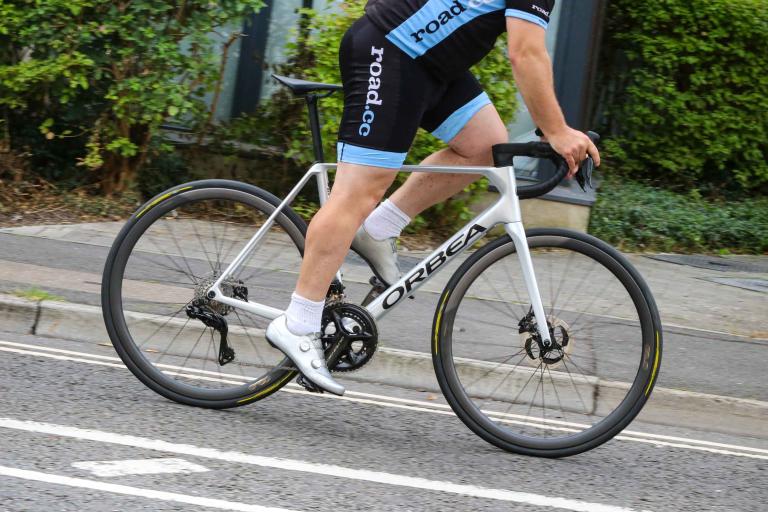
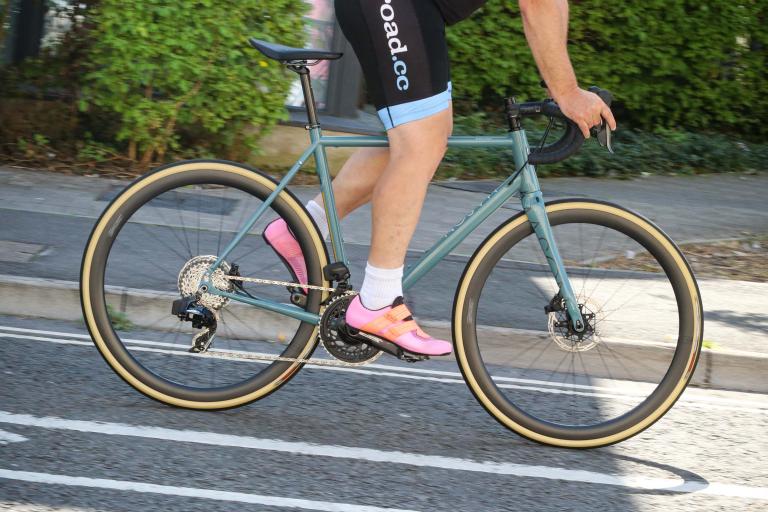
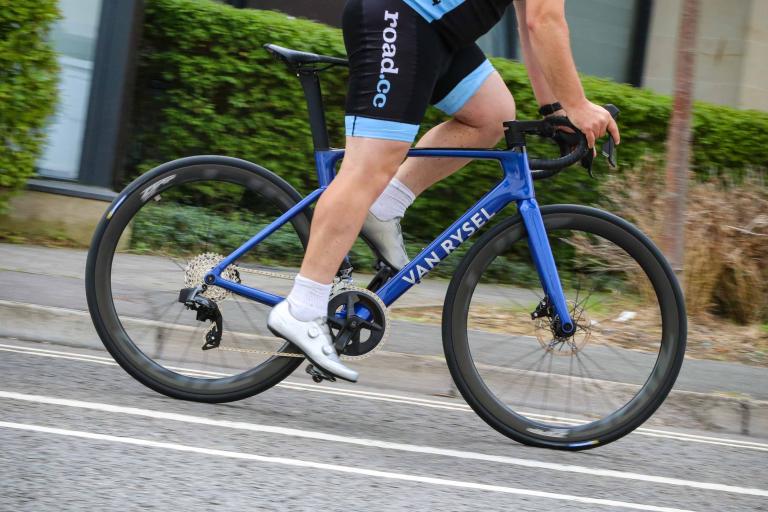
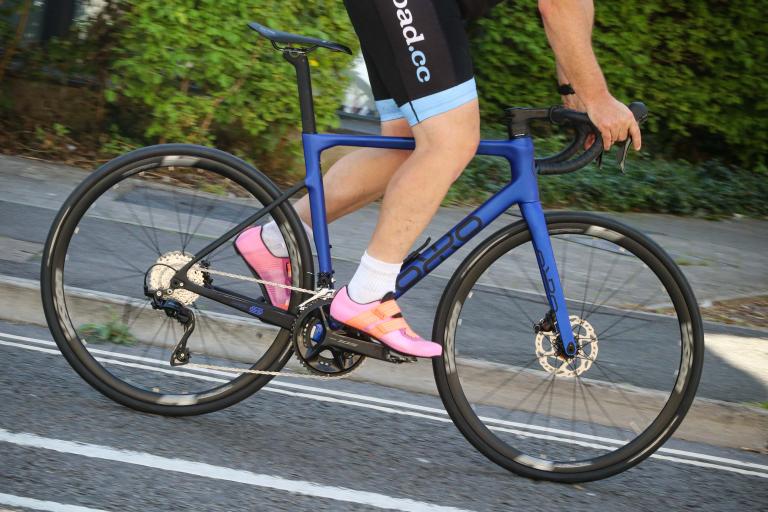
Add new comment
26 comments
Do your research Road.cc. One of the big attractions of this bike is that you can fit 28s AND guards. Pretty sure Kinesis even mention it in all their press material.
Mine is blue, to brighten up those grey winter rides.....plus black is boring.
'Brifters is a stupid word that clearly identifies the user as a fool.'
...and as such, plays a very important role. Long live that word.
Are the bikes tested by you guys ever tested outside of the park that seems to feature in every bike test article?!
I've got a 54, the virtual top tube is 55.6cm so it's closer to a 56 than the 57. My other main bike is a 56.
As for brifters... I shall use that at each and every opportunity and enjoy the derision.
Brifters is a stupid word that clearly identifies the user as a fool. Everyone knows they are called Grake Shivers.
No need to 'ditch the guards'to fit 28s, there's plenty of clearance for both.
No need to 'ditch the guards'to fit 28s, there's plenty of clearance for both.
Very useful info, thanks for that.
Agree with bendertherobot re price - much more cost effective to buy f&f, then source the bits separately. More satisfying too.
I've had mine for 15 months or so. It's done a bit of everything for me, including carrying all my shopping each week, taking me to university each day and being used for longer rides on weekends. I have a rack and guards fitted to make it more practical.
I built mine up from the frame only option with Campag. Lovely first do-it-all bike.
Old frames always had chain pips (although I didn't know they had a name - they were just there). Changing rear punctures was much easier then. So.. good for them.
Super Company. Enjoying a 2nd winter on Crosslite
It is 54cm, not 55. Just in the process of building a 54cm uo with the bits from a mis-judged eBay buy.
2 years I've had this bike and thanks to Road CC now I know... a chain pip!
I've stared at it and wondered many times. I will use it every time the wheel comes out now. Thanks.
By the way, I agree about the brakes. Get some Shimano long drops and it'll transform the bike.
*wanders over to stare at bike*
Ohhhhhhh! Me too. How excellent.
I got a f&f secondhand and built it up with Shimano long drops, never had a braking problem. In fact, it's great at stopping (Fulcrums and 4000s too).
When companies change the spec to keep it within the old price I do wonder whether the price is, in fact, a good one.
If the frame is £239 and you can then get the wheels for £75 and Groupset for £265 then where does the rest of the spec go to? I know you substitute long drop brakes. Finishing kit takes a bit. But, does the T2 look a bit overpriced now? Does it really need spec changes to keep it within the cycle scheme limit?
I have no strong opinion either way, but I'm aware that it is universally derided and now, so are you.
HTH.
I think you'll find that brifters is a universally derided term...
It's STIs for Shimano, Ergo levers for Campag and Doubletap levers for SRAM.
if it was 'universally derided' then no-one would be using it. and yet, here we all are. if you don't like it, that's okay.
"brifters"??
brake / shifters .... they've been known as brifters for ages !!
i bought the t2 frame a couple of years ago after i had a frame failure on another bike i was pleasantly surprised with the ride (as i had bought it specifically for the mudguard clearance) it is faster than i would have expected and has served well over the past couple of winters
i bought the t2 frame a couple of years ago after i had a frame failure on another bike i was pleasantly surprised with the ride (as i had bought it specifically for the mudguard clearance) it is faster than i would have expected and has served well over the past couple of winters
In the article you say it's available in 48, 51, 54, 57, 60 and 63cm - but in the notes you say it's a 55.
Might seem pedantic but for those sizing the bike prior to buying it would be good to know if thats a 54 or a 57!
Cheers.
Hi alotronic,
Sorry for the confusion. The bike in the picture is a 54 (that's me on it) but the one Jo actually tested is a 57 - there was some logical reason why that is… but I can't actually remember what it is now, but I do know that it seemed like a good idea at the time. Not sure where the 55 came from - some fumble fingered typing when we were adding it to our testing system.
Thanks Tony, all makes sense now. I am not really a pedant... well I am when it comes to frame sizing